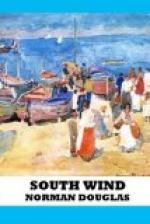For the rest, there are indications to show that such was not the original condition of affairs on the island. On the contrary, certain legends still current among the country-folk lead one to suspect that fountains once flowed on this arid rock. And more than legends. Monsignor Perrelli, in his antiquities of nepenthe, has gone into the subject with his usual thoroughness. The reader who takes the trouble to consult that work will find, in the twenty-sixth chapter of the third section dealing with the Natural Productions and Water-Supply of the island, an enumeration of no less than twelve fountains still flowing during the author’s lifetime. Some of them issued high up, in rocky clefts; others at the middle heights, among vineyards and orchards; the majority at, or near, the seashore. All of these springs, he tells us, had the following features in common: they were more or less hot, unpleasant to the taste, of foetid odour and therefore unfit for culinary or other common uses. “But let it not be supposed,” he hastens to add, “that they were worthless, inasmuch as there is no such thing as a worthless gift of Providence. Whoever argues on such fallacious lines,” he says, “will stand convicted both of folly and of irreverence, seeing that it is the business of mankind, when confronted by a phenomenon which seems to mock their intelligence, humbly to ponder the evidence—to investigate causes and ascertain results.” In the present case the utility of the waters, if not for cooking or drinking then for other specific purposes, had been put to the proof time out of mind, in an empirical fashion; though it was not till the reign of the Good Duke Alfred that a series of classical experiments placed our knowledge of their medicinal properties on a sound scientific footing.
In a dissertation attached to this twenty-sixth chapter—a dissertation larded with illustrative extracts from Galen Celsus, Avicenna, Antonius Musa, Oribasius Salvus and about fifty others of the ancients who professed the healing art—Monsignor Perrelli condenses for his readers the results of these classical experiments; he hands down the names of these springs and their manifold healing virtues.
The Fountain of Saint Calogero, described as one of the most famous, was lukewarm, of ammoniacal and alkaline flavour; a glassful of it produced the most violent retchings and vomitings. Properly applied, however, the water had been found to relieve the gout, the discomforts of child-bearing, leprosy, irritation of the mucous membrane of the nose, impetigo, strabismus and ophthalmia. If the patient observed care in his diet, avoiding articles of calorific nature such as fried fish and boiled lentils, he would find himself greatly benefited by its use in the case of cornucopic hydrocephalus, flatulence, tympanitis and varicose veins. It was useful, furthermore, as a cure for the stings of scorpions and other venomous beasts.




